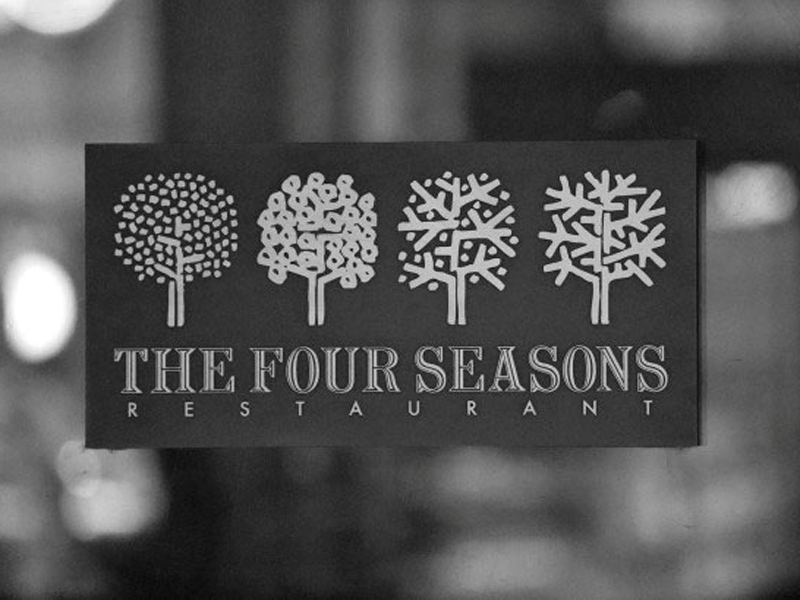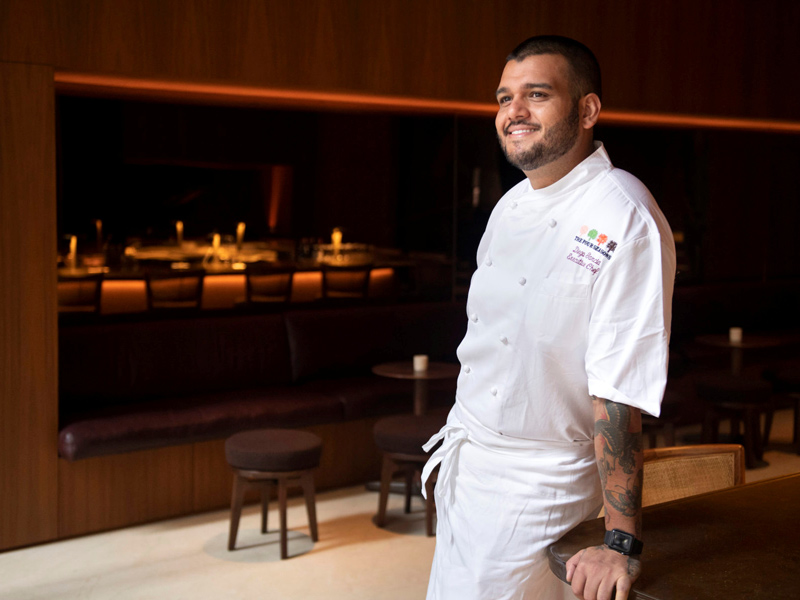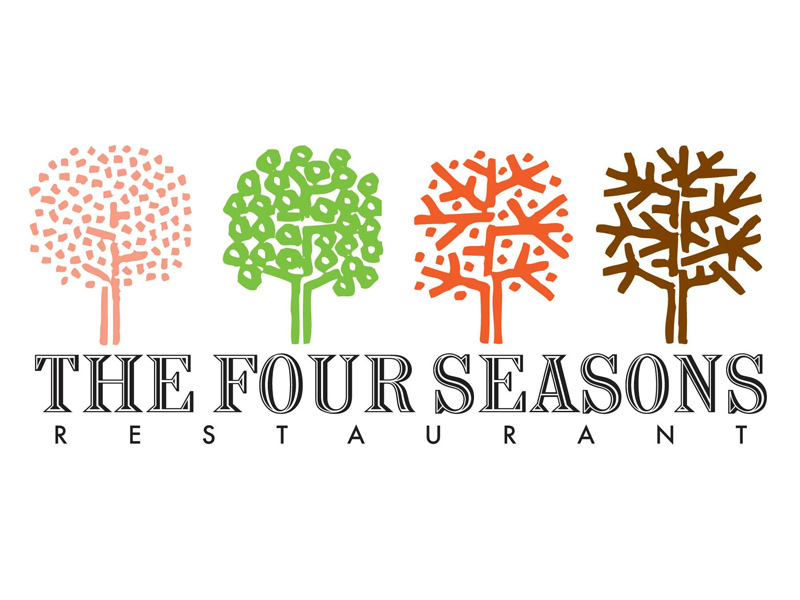I was a kid, still in school. The year was 1958 and the Canadian distiller and Seagram heiress, Phyllis Lambert, had just witnessed the completion of the soaring, Mies Van de Roe-designed Seagram Building, at the corner of Park Ave and 52nd Street in New York City.
A year later THE FOUR SEASONS restaurant opened there. It was designed by the influential architect, Philip Johnson (best known to Twin Citians as the man who gave us the IDS Center).
The spectacular space was ahead of its time. So, too, was the food philosophy of its owner, Joseph Baum. Before anyone was talking about seasonal food, local sourcing, or farm-to-table cuisine (this was years before Alice Waters revealed that notion to California), Baum introduced what he called New American Cuisine, which was predicated on quality, freshness and seasonality. Mimi Sheraton, who later became the New York Times food critic, and James Beard were menu consultants.
The restaurant was a magnet not just for New York’s A-Listers, but for the global elite. To cite a few: The Duke and Duchess of Windsor, Jack and Jackie (although not together…hmmmm?), Sophia Loren, and a young Henry Kissinger (who’s reported to have always ordered the $40 truffle-strewn baked potato). In later years, Martha Stewart, Princess Diana, Tina Brown and even the Dalai Lama and his saffron-clad entourage frequented the restaurant. The table-hopping was discreet…no lingering…almost orchestrated, like a ballet.
We’ve all heard the term “Power Lunch.” Esquire magazine coined it in reference to the Four Seasons in 1979. This was the place where book deals were signed, decisions made, and mergers were negotiated. Potentates plotted and planned. Business victories were celebrated, marriages were made and ended here.
The main action took place in the Pool Room, an absolutely breathtaking space with 22-foot-high ceilings and a white marble-clad 20-by-20-foot pool, dead center. The pool’s four corners were anchored by trees that honored the menu offerings and changed with the season. The other dining room, The Grill Room, boasted the same high ceilings and lustrous walnut walls, but it was definitely a step down. I’ve heard it said that the Grill Room was a country club; the Pool Room, a cruise ship.
During the mid-1970s, I was traveling to New York on a regular basis, about every other week. Knowing my deep interest in food and restaurants, and feeling sorry for the deprivation I endured as a native of the “fly-over” Midwest, my Big Apple clients enjoyed taking me to New York’s newest and finest dining destinations, including legendary restaurants like Lutece, La Caravelle, Quilted Giraffe, Tavern on the Green, 21 Club, and Le Cirque.
So it was on one of my first trips that I was lucky enough to be invited by a client to The Four Seasons for a drink. The square-shaped bar was centered beneath a gigantic seasonal spray of dazzling flowers, hanging from above. The lofty windows were draped with metal beads that rippled softly from a gentle breeze emanating from hidden floor vents. This midwestern bumpkin felt like he was at the center of the universe, where only important things could happen.
Over the next few years, I went back to the bar half a dozen times. Only once did I dine in the restaurant. It was early – probably around 5:30 or 6PM – the only time we could snag a table without an impossible-to-secure reservation. The host guided us to – and through –the see-and-be-seen Pool Room to “Siberia”: the ass end of the Grill Room.
I don’t remember what exactly we had for dinner except that there was an abundance of theater, with tableside preparations and plenty of flourishes. I also remember that it was insanely expensive.
Perhaps the restaurant was at its best when New York was at its worst – with Mayor Ed Koch trying to get a handle on the crime-ridden, crumbling and bankrupt metropolis. I don’t know if folks realize how much the Four Seasons must have meant to the city during those troubled times.
Servers, formally attired in Tom Ford tuxedos, served specialties like Long Island duck for two, deftly carved tableside ($150!). Sole Meuniere, deboned before your eyes, set you back $95, but was worth a visit for that alone. Other signature dishes included black bass ceviche ($35), crab cakes ($64), hand-carved roast lamb ($65), sea urchin ravioli, chocolate souffle, a chocolate/salted caramel tart, and a $38 tuna burger. Regulars were treated with a touch of whimsy….a basketball-sized cloud of pink cotton candy delivered at the end of their meal. The guests loved it, and their ratings were reflected in the Zagat Guide’s perennially stellar ratings for the food.
I don’t know for sure, but as good as the cooking was, the menu may not have even been the point. Perhaps the Four Seasons was, first and foremost, a stage for superstar luminaries.
But all stars fade eventually, and beginning in the late 1990s, the Power Lunch had begun to lose its luster. Over the next two decades, formal, stratospherically expensive cuisine was long past its “use by” date. People had just stopped eating that way, and the Four Season’s clientele had moved on. To make matters worse, Julian Niccolini, the affable and gracious host and partner, was very publicly accused of multiple sexual allegations about the same time that the Me Too movement was gaining traction. Women ignored the place.
And so, after 57 years, the landlord declined to renew the restaurant’s lease.
New investors, however, promptly stepped in. Probably buoyed and maybe a little starstruck by the name, they ponied up over $30 million to build a new Four Seasons a few blocks to the south.
Now, let me pause for a little “inside baseball” wisdom. The rule of thumb is that sales need to double the investment in order for your restaurant to succeed. So do the math: Invest $30 million, you better do $60 million in sales.
Guess what?
The new Four Seasons permanently closed in June of 2019, less than a year after it opened.
The New York Post, in article entitled “Why the Four Seasons Revival Never Had a Chance,” commented that even though $30 million was spent, and despite bringing aboard a talented chef with a pedigree that included Le Bernardin, the restaurant was doomed. The new space didn’t have the drama and grandeur of the Seagram Building. The décor was tasteful and pleasant, but ceilings were low and the dining rooms lackluster. The place felt like a feeble imitation of the original. But the real problem was that the restaurant’s time had passed. People just didn’t show up. The kind of dining experience was no longer relevant to them.
As it says in Ecclesiastes 3: 1-22, “For everything there is a season…a time to be born, a time to die.”
RIP, Four Seasons. You were significant. You important. You were meaningful. You were good.
You had a LARGE LIFE.
WTF, Phil













Never had a better meal than the duck. Dining here was always a celebration of fresh, seasonal, interesting! So sad it is gone.